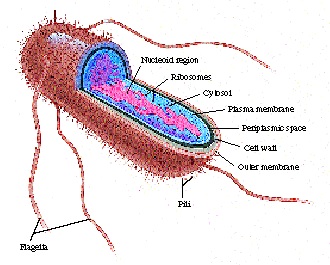
An organism of the kingdom Monera (or Prokaryotae), comprising the bacteria and cyanobacteria, characterized by the absence of a distinct, membrane-bound nucleus or membrane-bound organelles, and by DNA that is not organized into chromosomes. Also called moneran.

General Characteristics
One differentiating characteristic is that prokaryotes are
asexual, meaning their offspring nearly always bear the exact
characterisitcs of the parent cell. (In fact, the cell essentially replicates
itself according to its own DNA and then divides itself from the newly created
cell.) Since the Prokaryotes exhibit this asexual behavior as opposed to
sexual behavior, where a recombination of chromosones occur to form
unique entities (as with humans), evolution of the prokaryotic cell has been
fairly stagnant over its two billion year lifespan. Additionally, at the time of
Symbiosis, prokaryotes were anaerobic, that is, they did not use
oxygen as a fundamental necessity to live. As for nutrition
distribution, the small size of prokaryotes provides a high ratio of surface
area to volume, making diffusion an adequate means for distributing nutrients
throughout the cell.
Abundance
Prokaryotic cells and fossils have have been found in almost every conceivable environment on the earth, from hot sulfur springs to beneath the ocean floor and within larger cells. Overall, Prokaryotes account for a significant portion of the past and present biomass on earth.